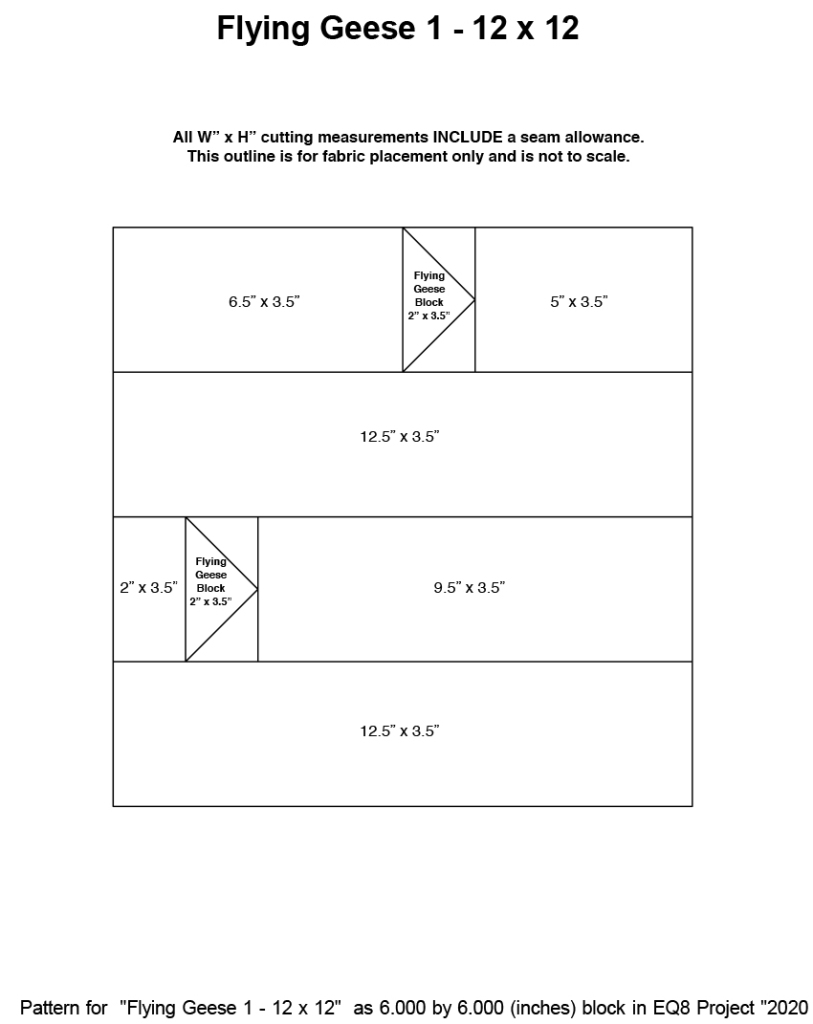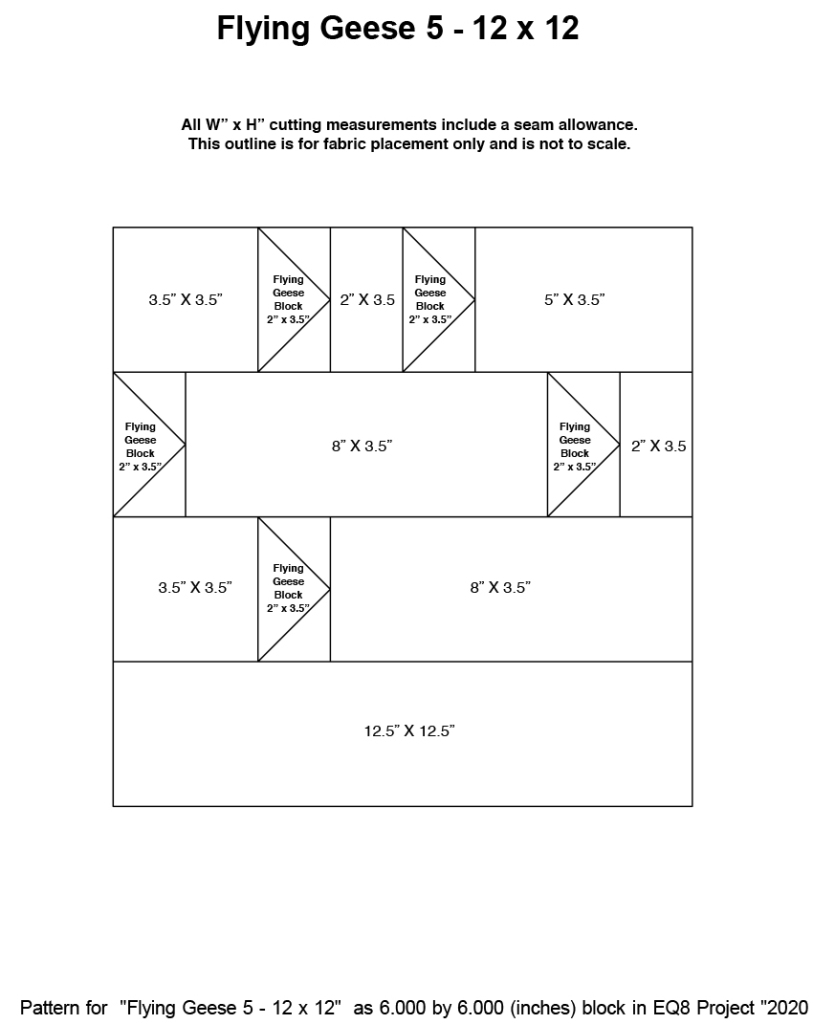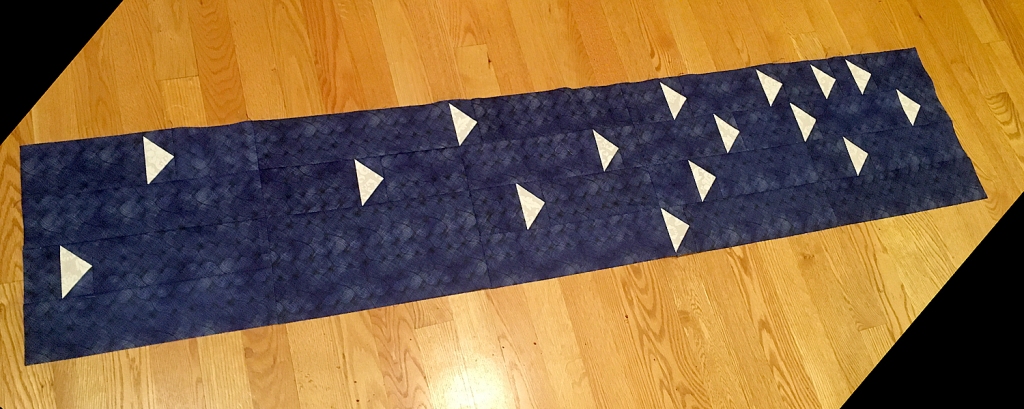
This is the third installment in the 2020 Seattle Modern Quilt Guild BOM project! Your guides on this journey are Susan Pray (IG: @sushi.farmer) and Kathy McGinnis (IG: @a_swede_life).
This month our row-by-row-along will give directions to assemble the five 12” x 12” (finished size) square blocks that make up the second row of flying geese in sky fabric. Part I covers geese construction and Part II covers block assembly. This month will seem absurdly simple compared to last month’s block construction and will take a lot less time to finish.
You will need less than a FQ of fabric or an equal amount of scraps for your geese and about ¾ of a yard of sky fabric for this row. Please see yardage requirements in February post for a full accounting of all yardage suggestions. Remember you can use scraps instead of yardage for this whole project. If you wish to do that the block diagrams listed below will give you all cut sizes you need to make each block separately.
Part I: Make Your Geese
A No Waste method (also called the 4 at a Time method) serves us quite well as there are a total of 16 geese, yes that was done on purpose. If you’re familiar with this method of construction just skip down to fabric cutting directions and get your sew on my friends. If this is a new-to-you method then we have listed a few links to a video and a tutorial for your perusal although there are photos of each step included below.
No waste flying geese tutorials:
If you wish to create improv flying geese please feel free to do so! This quilt pattern is all about the freedom to make it all yours. Below is a link to an improv tutorial. Please note you’ll need to make all your geese the same size, 2” x 3.5” (unfinished), to fit into the blocks that make up the second row of this quilt.
Improv flying geese tutorial:
Total number of Geese needed (UNFINISHED size):
Cutting Directions:
Cut 4 large squares from your geese fabric at 4-¼” x 4-¼”
Cut 16 smaller squares from your sky fabric at 2-⅜” x 2-⅜”
Please do not round up or down for these cuts, they need to be as exact as you can make them. Yes they’re a pesky measurement but that’s what makes these magical “no waste” units.
Mark a line corner to corner on the back side of the smaller squares. Lay two of the smaller squares right sides together on top of the larger square as shown here:

Sew a scant ¼” seam on both sides of your corner to corner mark and cut on the mark.

Press open and lay another smaller marked square right sides together like this:

Again, sew a ¼” seam on both sides of your mark and cut on the mark. Repeat with the fourth and final smaller square.
Press your 4 newly hatched geese open and admire them. They should measure 2” x 3 ½” unfinished.
Part II: Block Assembly
Cutting directions for the background sky fabric:
There are five unique blocks to assemble for the top row. If you’re working from yardage cut the following WOF strips from your sky fabric and subcut as listed. Please disregard if you’re working from scraps and cut fabrics for each block as you go along using the block diagrams at the end of this post.
- Cut qty 6 WOF – 3 ½” strips from your sky fabric yardage.
Subcut the 3.5” strips into:
- (7) 12.5”
- (2) 11”
- (2) 9.5”
- (4) 8”
- (3) 6.5”
- (1) 6”
- (1) 5.5”
- (3) 5”
- (5) 3.5”
- (4) 2”
Keep these 30 pieces in an orderly fashion as you’ll need to pull them by size to assemble the blocks.
Flying geese diagrams:
Using your geese and subcut strips, lay out and sew together your five 12.5” x 12.5” (unfinished size) blocks according to the following diagrams:

Download PDF: SMQG_2020BOM_FLYING_GEESE_BLOCK_1
Pinterest Board: https://www.pinterest.com/quiltguild/medallion-quilt-inspiration/
Basic Seminole Patchwork by Cheryl Greider Bradkin, 1990
Liberated Quiltmaking II by Gwen Marston, 2010
Modern Blocks: 99 Quilt Blocks from Your Favorite Designers, complied by Suzanne Woods, 2011
Modern Plus Sign Quilts by Cheryl Brickey and Paige Alexander, 2018
Simply Seminole by Dorothy Hanisko, 1997

Download PDF: SMQG_2020BOM_FLYING_GEESE_BLOCK_2
Pinterest Board: https://www.pinterest.com/quiltguild/medallion-quilt-inspiration/
Basic Seminole Patchwork by Cheryl Greider Bradkin, 1990
Liberated Quiltmaking II by Gwen Marston, 2010
Modern Blocks: 99 Quilt Blocks from Your Favorite Designers, complied by Suzanne Woods, 2011
Modern Plus Sign Quilts by Cheryl Brickey and Paige Alexander, 2018
Simply Seminole by Dorothy Hanisko, 1997

Download PDF: SMQGSMQG_2020BOM_FLYING_GEESE_BLOCK_3
Pinterest Board: https://www.pinterest.com/quiltguild/medallion-quilt-inspiration/
Basic Seminole Patchwork by Cheryl Greider Bradkin, 1990
Liberated Quiltmaking II by Gwen Marston, 2010
Modern Blocks: 99 Quilt Blocks from Your Favorite Designers, complied by Suzanne Woods, 2011
Modern Plus Sign Quilts by Cheryl Brickey and Paige Alexander, 2018
Simply Seminole by Dorothy Hanisko, 1997

Download PDF: SMQG_2020BOM_FLYING_GEESE_BLOCK_4
Pinterest Board: https://www.pinterest.com/quiltguild/medallion-quilt-inspiration/
Basic Seminole Patchwork by Cheryl Greider Bradkin, 1990
Liberated Quiltmaking II by Gwen Marston, 2010
Modern Blocks: 99 Quilt Blocks from Your Favorite Designers, complied by Suzanne Woods, 2011
Modern Plus Sign Quilts by Cheryl Brickey and Paige Alexander, 2018
Simply Seminole by Dorothy Hanisko, 1997

Download PDF: SMQG_2020BOM_FLYING_GEESE_BLOCK_5
Sew the finished blocks together in this configuration:

Pinterest Board: https://www.pinterest.com/quiltguild/medallion-quilt-inspiration/
Basic Seminole Patchwork by Cheryl Greider Bradkin, 1990
Liberated Quiltmaking II by Gwen Marston, 2010
Modern Blocks: 99 Quilt Blocks from Your Favorite Designers, complied by Suzanne Woods, 2011
Modern Plus Sign Quilts by Cheryl Brickey and Paige Alexander, 2018
Simply Seminole by Dorothy Hanisko, 1997
Be Social!
Tag your progress pictures on Instagram!
#cascadiacabinquilt #smqgbom2020 #seamqg #seattlemqg #showusyourmqg and don’t forget to use #seattlemqgsewathome since we are all social distancing.
